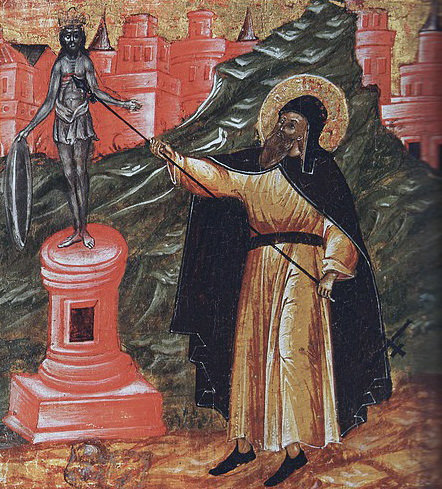In chapter seven of The Darkening Age: The Christian
Destruction of the Classical World, Catherine Nixey wrote:
Constantine… demanded that the statues be taken from the temples. Christian officials, so it was said, travelled the empire, ordering the priests of the old religion to bring their statues out of the temples. From the 330s onwards some of the most sacred objects in the empire started to be removed. It is hard, today, to understand the enormity of Constantine’s order. If Michelangelo’s Pietà were taken from the Vatican and sold, it would be considered a terrible act of cultural vandalism—but it wouldn’t be sacrilege as the statue is not in itself sacred. Statues in Roman temples were. To remove them was a gross violation, and Constantine knew it…
The possibility that Jesus would triumph over all other gods would, at the time, have seemed almost preposterous. Constantine was faced with an intransigent population who insisted on worshipping idols at the expense of the risen Lord. He realized that conversion would be more ‘easily accomplished if he could get them to despise their temples and the images contained therein’. And what better way to teach wayward pagans the vanity of their gods than by cracking open their statues and showing that they were, quite literally, empty? Moreover, a religious system in which sacrifice was central would struggle to survive if there was nothing to sacrifice to. There was good biblical precedent for his actions. In Deuteronomy, God had commanded that His chosen people should overthrow altars, burn sacred groves and hew down the graven images of the gods. If Constantine attacked the temples then he was not being a vandal. He was doing God’s good work.
And so it began. The great Roman and Greek temples were— or so Eusebius said—broken open and their statues brought out, then mutilated…
Not all the temple statues were melted down. The ‘tyrant’ Constantine also had an eye for art and many objects were shipped back as prize baubles for the emperor’s new city, Constantinople (Constantine, like Alexander the Great, was not one for self-effacement). The Pythian Apollo was put up as ‘a contemptible spectacle’ in one square; the sacred tripods of Delphi turned up in Constantinople’s hippodrome, while the Muses of Helicon found themselves relocated to Constantine’s palace. The capital looked wonderful. The temples looked—were—desecrated. As his biographer wrote with satisfaction, Constantine ‘confuted the superstitious error of the heathen in all sorts of ways’.
And yet despite the horror of what Constantine was asking his subjects to do there was little resistance…
Christianity could have been tolerant: it was not preordained that it would take this path. There were Christians who voiced hopes for tolerance, even ecumenicalism. But those hopes were dashed. For those who wish to be intolerant, monotheism provides very powerful weapons. There was ample biblical justification for the persecution of non-believers.
The Bible, as a generation of Christian authors declared, is very clear on the matter of idolatry. As the Christian author Firmicus Maternus reminded his rulers—perfectly correctly—there lay upon emperors an ‘imperative necessity to castigate and punish this evil’. Their ‘severity should be visited in every way on the crime’. And what precisely did God advise as a punishment for idolatry? Deuteronomy was clear: a person indulging in this should be stoned to death. And if an entire city fell into such sin? Again, the answer was clear: ‘destruction is decreed’.
The desecration continued for centuries. In the fifth century AD, the colossal statue of Athena, the sacred centrepiece of the Acropolis in Athens, and one of the most famous works of art in the empire, was torn down from where she had stood guard for almost a thousand years, and shipped off to Constantinople—a great coup for the Christian city and a great insult to the ‘pagans’…
 Note of the Ed.: After the centuries, Europeans even forgot how the Greco-Roman sculptures that were destroyed looked like. My guess is that Constantine’s bishops were not Aryans. Destroying a representation of the beauty of the Aryan physique was part of the Semitic takeover of white society: Let’s destroy your self-image as a means to undermine your self-esteem. Something similar is happening today with the religion of Holocaustianity: Let’s undermine your self-image from a decent person to historic grievances so that you may accept masses of non-white immigrants.
Note of the Ed.: After the centuries, Europeans even forgot how the Greco-Roman sculptures that were destroyed looked like. My guess is that Constantine’s bishops were not Aryans. Destroying a representation of the beauty of the Aryan physique was part of the Semitic takeover of white society: Let’s destroy your self-image as a means to undermine your self-esteem. Something similar is happening today with the religion of Holocaustianity: Let’s undermine your self-image from a decent person to historic grievances so that you may accept masses of non-white immigrants.
History is written by the winners and the Christian victory was absolute. The Church dominated European thought for more than a millennium. Until 1871 the University of Oxford required that all students were members of the Church of England, while in most cases to be given a fellowship in an Oxford college one had to be ordained. Cambridge was a little freer—but not much.
This was not an atmosphere conducive to criticism of Christianity and indeed, in English histories, there was little. For centuries, the vast majority of historians unquestioningly took up the Christian cause and routinely and derogatorily referred to non-Christians as ‘pagans’, ‘heathens ‘ and ‘idolaters’. The practices and sufferings of these ‘pagans’ were routinely belittled, trivialized or—more often—entirely ignored. As one modern scholar has observed: ‘The story of early Christian history has been told almost wholly on the basis of Christian sources.’